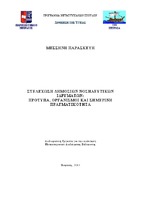Στελέχωση δημόσιων νοσηλευτικών ιδρυμάτων: πρότυπα, οργανισμοί και σημερινή πραγματικότητα. = The staffing of public hospitals: standards, organizations and current reality.

View/
Subject
Νοσοκομεία -- Διοίκηση και οργάνωση ; Διοίκηση και οργάνωση προσωπικού ; Διοίκηση και οργάνωση υπηρεσιών υγείαςAbstract
Covering a period while the global economic crisis has brought about significant reductions in the budget of the health sector through reductions in wages, layoffs, closures of care units, limiting care services, closure of entire hospitals and hospital mergers, both in Greece and in other countries of European Union, the issue of staffing in public hospitals is emerging, bringing intense research, but also of practical interest. According to a widely used definition the process of staffing includes a clear and systematic process of determining the numerical and qualitative composition of staff required to ensure the standards of care defined in a group of patients and in particular environment. Sufficient numerically and qualitatively staff helps to develop and improve the health level of the population, as the employment situation in health is connected with the improvement of health population. The primary objective of this paper is to understand the key role of staffing in public hospitals in the organization and operation of the health system. Furthermore, models and organizations are presented and a reference to the actual situation today is being attempted. In order to analyze the role of the staffing of public hospitals, this paper is divided into four sections. In the first section, manning standards of medical, nursing, administrative and technical services of hospitals are established. In the second section, there is a detailed report on organizations and their forms, there are presented quantitative and qualitative data on human resources in health services in Greece from 1980 to 2000 and dealt with the issue of quality health care in relation to the staffing of health services and the negative impact of the lack of staff. In the third section, there is a detailed report on the situation today and it is attempted an approach of the current situation to identify possible deviations from international standards, through random selection of certain hospitals and using statistical health indicators. The conclusion is that the staffing of public hospitals is sufficient at least numerically without specific deviations from international standards. Finally, reference is made to significant changes to be made for the proper functioning of hospitals and how to overcome the problem of lack of nursing staff.


